Ran Gong
TeSO: Representing and Compressing 3D Point Cloud Scenes with Textured Surfel Octree
Aug 09, 2025Abstract:3D visual content streaming is a key technology for emerging 3D telepresence and AR/VR applications. One fundamental element underlying the technology is a versatile 3D representation that is capable of producing high-quality renders and can be efficiently compressed at the same time. Existing 3D representations like point clouds, meshes and 3D Gaussians each have limitations in terms of rendering quality, surface definition, and compressibility. In this paper, we present the Textured Surfel Octree (TeSO), a novel 3D representation that is built from point clouds but addresses the aforementioned limitations. It represents a 3D scene as cube-bounded surfels organized on an octree, where each surfel is further associated with a texture patch. By approximating a smooth surface with a large surfel at a coarser level of the octree, it reduces the number of primitives required to represent the 3D scene, and yet retains the high-frequency texture details through the texture map attached to each surfel. We further propose a compression scheme to encode the geometry and texture efficiently, leveraging the octree structure. The proposed textured surfel octree combined with the compression scheme achieves higher rendering quality at lower bit-rates compared to multiple point cloud and 3D Gaussian-based baselines.
Towards Autonomous Micromobility through Scalable Urban Simulation
May 01, 2025Abstract:Micromobility, which utilizes lightweight mobile machines moving in urban public spaces, such as delivery robots and mobility scooters, emerges as a promising alternative to vehicular mobility. Current micromobility depends mostly on human manual operation (in-person or remote control), which raises safety and efficiency concerns when navigating busy urban environments full of unpredictable obstacles and pedestrians. Assisting humans with AI agents in maneuvering micromobility devices presents a viable solution for enhancing safety and efficiency. In this work, we present a scalable urban simulation solution to advance autonomous micromobility. First, we build URBAN-SIM - a high-performance robot learning platform for large-scale training of embodied agents in interactive urban scenes. URBAN-SIM contains three critical modules: Hierarchical Urban Generation pipeline, Interactive Dynamics Generation strategy, and Asynchronous Scene Sampling scheme, to improve the diversity, realism, and efficiency of robot learning in simulation. Then, we propose URBAN-BENCH - a suite of essential tasks and benchmarks to gauge various capabilities of the AI agents in achieving autonomous micromobility. URBAN-BENCH includes eight tasks based on three core skills of the agents: Urban Locomotion, Urban Navigation, and Urban Traverse. We evaluate four robots with heterogeneous embodiments, such as the wheeled and legged robots, across these tasks. Experiments on diverse terrains and urban structures reveal each robot's strengths and limitations.
RoboVerse: Towards a Unified Platform, Dataset and Benchmark for Scalable and Generalizable Robot Learning
Apr 26, 2025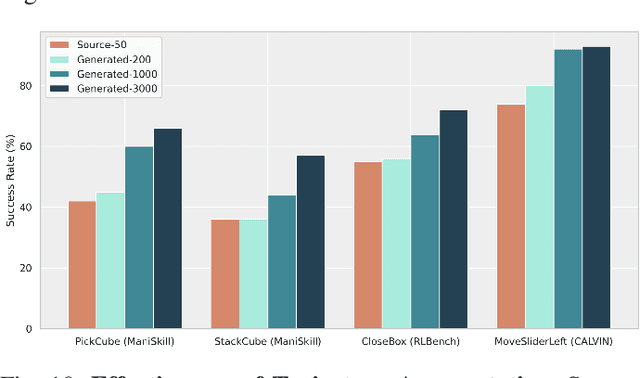
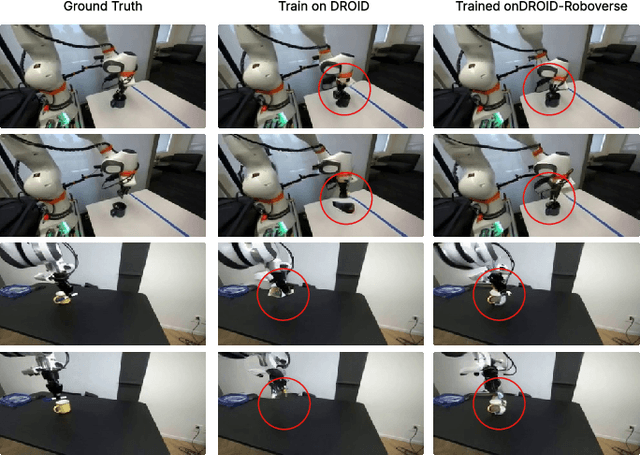
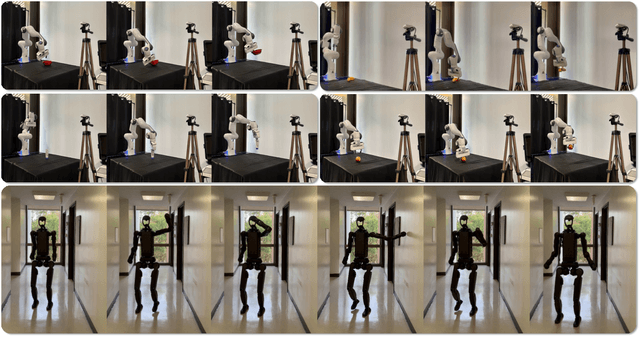
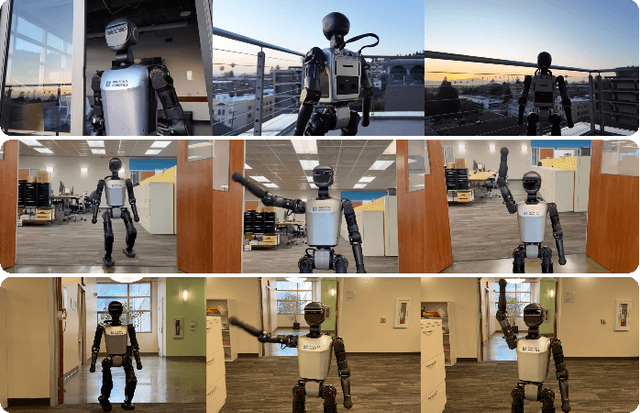
Abstract:Data scaling and standardized evaluation benchmarks have driven significant advances in natural language processing and computer vision. However, robotics faces unique challenges in scaling data and establishing evaluation protocols. Collecting real-world data is resource-intensive and inefficient, while benchmarking in real-world scenarios remains highly complex. Synthetic data and simulation offer promising alternatives, yet existing efforts often fall short in data quality, diversity, and benchmark standardization. To address these challenges, we introduce RoboVerse, a comprehensive framework comprising a simulation platform, a synthetic dataset, and unified benchmarks. Our simulation platform supports multiple simulators and robotic embodiments, enabling seamless transitions between different environments. The synthetic dataset, featuring high-fidelity physics and photorealistic rendering, is constructed through multiple approaches. Additionally, we propose unified benchmarks for imitation learning and reinforcement learning, enabling evaluation across different levels of generalization. At the core of the simulation platform is MetaSim, an infrastructure that abstracts diverse simulation environments into a universal interface. It restructures existing simulation environments into a simulator-agnostic configuration system, as well as an API aligning different simulator functionalities, such as launching simulation environments, loading assets with initial states, stepping the physics engine, etc. This abstraction ensures interoperability and extensibility. Comprehensive experiments demonstrate that RoboVerse enhances the performance of imitation learning, reinforcement learning, world model learning, and sim-to-real transfer. These results validate the reliability of our dataset and benchmarks, establishing RoboVerse as a robust solution for advancing robot learning.
TeamCraft: A Benchmark for Multi-Modal Multi-Agent Systems in Minecraft
Dec 06, 2024



Abstract:Collaboration is a cornerstone of society. In the real world, human teammates make use of multi-sensory data to tackle challenging tasks in ever-changing environments. It is essential for embodied agents collaborating in visually-rich environments replete with dynamic interactions to understand multi-modal observations and task specifications. To evaluate the performance of generalizable multi-modal collaborative agents, we present TeamCraft, a multi-modal multi-agent benchmark built on top of the open-world video game Minecraft. The benchmark features 55,000 task variants specified by multi-modal prompts, procedurally-generated expert demonstrations for imitation learning, and carefully designed protocols to evaluate model generalization capabilities. We also perform extensive analyses to better understand the limitations and strengths of existing approaches. Our results indicate that existing models continue to face significant challenges in generalizing to novel goals, scenes, and unseen numbers of agents. These findings underscore the need for further research in this area. The TeamCraft platform and dataset are publicly available at https://github.com/teamcraft-bench/teamcraft.
Low Latency Point Cloud Rendering with Learned Splatting
Sep 24, 2024


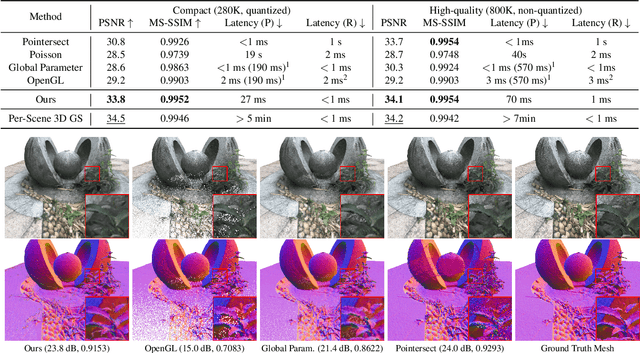
Abstract:Point cloud is a critical 3D representation with many emerging applications. Because of the point sparsity and irregularity, high-quality rendering of point clouds is challenging and often requires complex computations to recover the continuous surface representation. On the other hand, to avoid visual discomfort, the motion-to-photon latency has to be very short, under 10 ms. Existing rendering solutions lack in either quality or speed. To tackle these challenges, we present a framework that unlocks interactive, free-viewing and high-fidelity point cloud rendering. We train a generic neural network to estimate 3D elliptical Gaussians from arbitrary point clouds and use differentiable surface splatting to render smooth texture and surface normal for arbitrary views. Our approach does not require per-scene optimization, and enable real-time rendering of dynamic point cloud. Experimental results demonstrate the proposed solution enjoys superior visual quality and speed, as well as generalizability to different scene content and robustness to compression artifacts. The code is available at https://github.com/huzi96/gaussian-pcloud-render .
Bits-to-Photon: End-to-End Learned Scalable Point Cloud Compression for Direct Rendering
Jun 09, 2024



Abstract:Point cloud is a promising 3D representation for volumetric streaming in emerging AR/VR applications. Despite recent advances in point cloud compression, decoding and rendering high-quality images from lossy compressed point clouds is still challenging in terms of quality and complexity, making it a major roadblock to achieve real-time 6-Degree-of-Freedom video streaming. In this paper, we address this problem by developing a point cloud compression scheme that generates a bit stream that can be directly decoded to renderable 3D Gaussians. The encoder and decoder are jointly optimized to consider both bit-rates and rendering quality. It significantly improves the rendering quality while substantially reducing decoding and rendering time, compared to existing point cloud compression methods. Furthermore, the proposed scheme generates a scalable bit stream, allowing multiple levels of details at different bit-rate ranges. Our method supports real-time color decoding and rendering of high quality point clouds, thus paving the way for interactive 3D streaming applications with free view points.
Position Paper: Agent AI Towards a Holistic Intelligence
Feb 28, 2024Abstract:Recent advancements in large foundation models have remarkably enhanced our understanding of sensory information in open-world environments. In leveraging the power of foundation models, it is crucial for AI research to pivot away from excessive reductionism and toward an emphasis on systems that function as cohesive wholes. Specifically, we emphasize developing Agent AI -- an embodied system that integrates large foundation models into agent actions. The emerging field of Agent AI spans a wide range of existing embodied and agent-based multimodal interactions, including robotics, gaming, and healthcare systems, etc. In this paper, we propose a novel large action model to achieve embodied intelligent behavior, the Agent Foundation Model. On top of this idea, we discuss how agent AI exhibits remarkable capabilities across a variety of domains and tasks, challenging our understanding of learning and cognition. Furthermore, we discuss the potential of Agent AI from an interdisciplinary perspective, underscoring AI cognition and consciousness within scientific discourse. We believe that those discussions serve as a basis for future research directions and encourage broader societal engagement.
An Interactive Agent Foundation Model
Feb 08, 2024



Abstract:The development of artificial intelligence systems is transitioning from creating static, task-specific models to dynamic, agent-based systems capable of performing well in a wide range of applications. We propose an Interactive Agent Foundation Model that uses a novel multi-task agent training paradigm for training AI agents across a wide range of domains, datasets, and tasks. Our training paradigm unifies diverse pre-training strategies, including visual masked auto-encoders, language modeling, and next-action prediction, enabling a versatile and adaptable AI framework. We demonstrate the performance of our framework across three separate domains -- Robotics, Gaming AI, and Healthcare. Our model demonstrates its ability to generate meaningful and contextually relevant outputs in each area. The strength of our approach lies in its generality, leveraging a variety of data sources such as robotics sequences, gameplay data, large-scale video datasets, and textual information for effective multimodal and multi-task learning. Our approach provides a promising avenue for developing generalist, action-taking, multimodal systems.
Agent AI: Surveying the Horizons of Multimodal Interaction
Jan 07, 2024



Abstract:Multi-modal AI systems will likely become a ubiquitous presence in our everyday lives. A promising approach to making these systems more interactive is to embody them as agents within physical and virtual environments. At present, systems leverage existing foundation models as the basic building blocks for the creation of embodied agents. Embedding agents within such environments facilitates the ability of models to process and interpret visual and contextual data, which is critical for the creation of more sophisticated and context-aware AI systems. For example, a system that can perceive user actions, human behavior, environmental objects, audio expressions, and the collective sentiment of a scene can be used to inform and direct agent responses within the given environment. To accelerate research on agent-based multimodal intelligence, we define "Agent AI" as a class of interactive systems that can perceive visual stimuli, language inputs, and other environmentally-grounded data, and can produce meaningful embodied action with infinite agent. In particular, we explore systems that aim to improve agents based on next-embodied action prediction by incorporating external knowledge, multi-sensory inputs, and human feedback. We argue that by developing agentic AI systems in grounded environments, one can also mitigate the hallucinations of large foundation models and their tendency to generate environmentally incorrect outputs. The emerging field of Agent AI subsumes the broader embodied and agentic aspects of multimodal interactions. Beyond agents acting and interacting in the physical world, we envision a future where people can easily create any virtual reality or simulated scene and interact with agents embodied within the virtual environment.
MindAgent: Emergent Gaming Interaction
Sep 19, 2023Abstract:Large Language Models (LLMs) have the capacity of performing complex scheduling in a multi-agent system and can coordinate these agents into completing sophisticated tasks that require extensive collaboration. However, despite the introduction of numerous gaming frameworks, the community has insufficient benchmarks towards building general multi-agents collaboration infrastructure that encompass both LLM and human-NPCs collaborations. In this work, we propose a novel infrastructure - MindAgent - to evaluate planning and coordination emergent capabilities for gaming interaction. In particular, our infrastructure leverages existing gaming framework, to i) require understanding of the coordinator for a multi-agent system, ii) collaborate with human players via un-finetuned proper instructions, and iii) establish an in-context learning on few-shot prompt with feedback. Furthermore, we introduce CUISINEWORLD, a new gaming scenario and related benchmark that dispatch a multi-agent collaboration efficiency and supervise multiple agents playing the game simultaneously. We conduct comprehensive evaluations with new auto-metric CoS for calculating the collaboration efficiency. Finally, our infrastructure can be deployed into real-world gaming scenarios in a customized VR version of CUISINEWORLD and adapted in existing broader Minecraft gaming domain. We hope our findings on LLMs and the new infrastructure for general-purpose scheduling and coordination can help shed light on how such skills can be obtained by learning from large language corpora.
 Add to Chrome
Add to Chrome Add to Firefox
Add to Firefox Add to Edge
Add to Edge